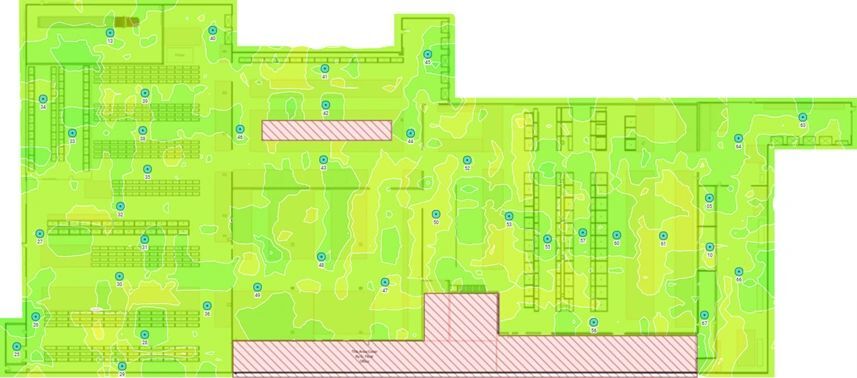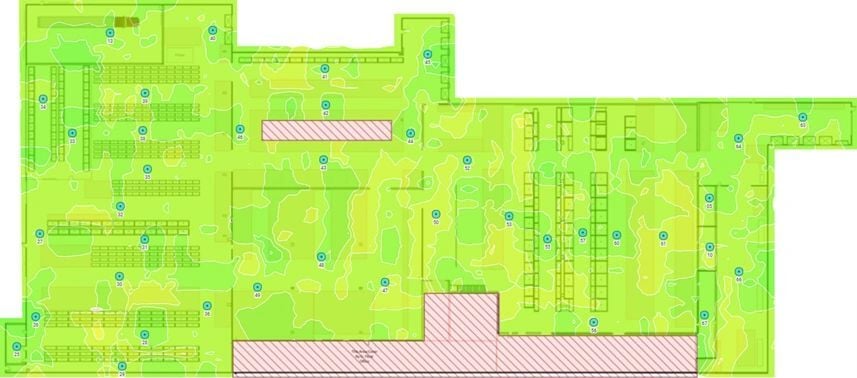
Pre-Deployment Wi-Fi Survey in Virginia, USA: From Plans to Performance
The reliability of a wireless network is fundamentally determined by its design. Before deploying any access points, it’s crucial to assess how radio frequency (RF) signals will travel through the facility, evaluate the impact of walls and materials on signal strength, and identify potential sources of interference that could hinder performance. Conducting a thorough pre-deployment wireless site survey provides this critical insight ensuring that coverage, capacity, and seamless roaming are built into the network from the very beginning.
At a multi-story facility in Virginia, we carried out a comprehensive pre-deployment survey using Ekahau predictive modeling, AP-on-a-stick site validation, and detailed spectrum analysis. This approach allowed us to develop an optimized access point placement plan—one that reduces co-channel interference, delivers consistent coverage at -67 dBm or better throughout the site, and creates a scalable foundation ready for future wireless technology advancements.
The Virginia facility is a large, multi-floor site that combines both office spaces and operational areas. This mix of environments presents unique challenges for wireless design. Open office layouts require high-density coverage to support a large number of simultaneous users, while warehouse-like areas demand stronger signal penetration through shelving, machinery, and structural materials.

Site Map
The survey objectives were clear:
- Ensure reliable signal coverage throughout the building.
- Design for seamless roaming so staff could move without losing connection.
- Optimize for throughput, supporting voice, video, and data with low latency.
Challenges and Constraints
Every facility presents its own obstacles, and this project was no exception. The building featured reinforced concrete walls and steel supports, both of which are notorious for attenuating wireless signals. These materials required careful modeling to avoid signal degradation.
The facility also contained equipment that contributed to RF interference. Industrial machinery, older wireless devices, and nearby external networks produced a crowded spectrum that required careful consideration. To further complicate matters, the client needed installation to be completed within a tight timeframe, allowing minimal margin for error. The survey needed to deliver a design that would not only perform flawlessly but also simplify and accelerate the deployment process.
Methodology
To ensure accuracy, our engineers took a hybrid approach, combining predictive software modeling with on-site testing.
The initial step involved uploading detailed floor plans into Ekahau Pro, a leading wireless design platform. Each wall, doorway, and partition was assigned a specific attenuation value to accurately model signal propagation. This predictive simulation enabled engineers to virtually test various access point placements, streamlining planning and reducing on-site trial and error.
Following this, the team conducted AP-on-a-stick tests at critical locations throughout the building. Temporary access points were mounted and live RF measurements collected using the Ekahau Sidekick, allowing us to compare real-world signal data to the predictive model and confirm that projected coverage would be realized in practice.

AP-on-a-Stick testing setup in the office location, using a ceiling-mounted access point at standard height to validate wireless coverage
Finally, a spectrum analysis was conducted to identify sources of interference. By capturing data across both the 2.4 GHz and 5 GHz bands, the team confirmed channel utilization and noise levels, which informed channel and power planning.
Key Findings
The results of the survey provided a clear roadmap for deployment. Predictive modeling combined with on-site testing showed multiple access points would provide complete coverage across the facility. The network design achieved 99.1 percent area coverage at -67 dBm or better, meeting the project’s stringent performance requirements.
The analysis also uncovered minor co-channel interference in the 2.4 GHz band. While this is typical in high-density environments, we mitigated the issue by implementing band steering, prompting devices to shift to the less congested 5 GHz band. This approach not only reduced interference but also boosted overall network performance.
Projected throughput levels exceeded 400 Mbps on average per zone, ensuring the network could support bandwidth-intensive applications like video conferencing, VoIP, and cloud services.
Signal Strengths

5 GHz Wi-Fi Signal Strength – Warehouse Coverage (-67 dBm)

2.4 GHz Wi-Fi Signal Strength – Warehouse Coverage (-67 dBm)
Recommendations
Based on the findings, the final design called for the deployment of Wi-Fi 6 access points equipped with dual-band antennas. These APs were strategically placed to balance coverage and capacity while maintaining a consistent roaming experience.
Channel and power levels were carefully tuned to minimize overlap and maximize performance. Band steering was recommended as a standard configuration, ensuring that devices made the best use of available spectrum. To future-proof the design, engineers also recommended provisioning sufficient backhaul capacity and ensuring the infrastructure could seamlessly support next-generation wireless standards when the client decides to adopt them.
Expected Impact
The survey results gave the client confidence that their network installation would deliver on day one. By addressing coverage gaps and interference in advance, the design virtually eliminated the risk of dead zones.
The precise AP placement plan will also reduce installation time, as installers can follow a tested blueprint without second-guessing locations. End users will benefit from seamless roaming and faster speeds, improving productivity across the board. Most importantly, the facility now has a future-ready network design, capable of supporting the latest devices and emerging wireless standards.
Best Practices and Lessons Learned
This project underscored the importance of conducting a thorough pre-deployment survey. Attempting to install Wi-Fi blindly can lead to wasted time, additional costs, and frustrated users. Instead, predictive design combined with live testing creates a reliable roadmap for success.
Other organizations planning a network upgrade can learn from this project by:
- Always validating predictive models with on-site data.
- Accounting for building materials and interference sources in the design.
- Planning for device density and future growth, not just current needs.
- Leveraging modern survey tools like Ekahau Pro and Sidekick to eliminate guesswork.
Please get in touch with the experts at Orion US today.

Image Source: Canva
